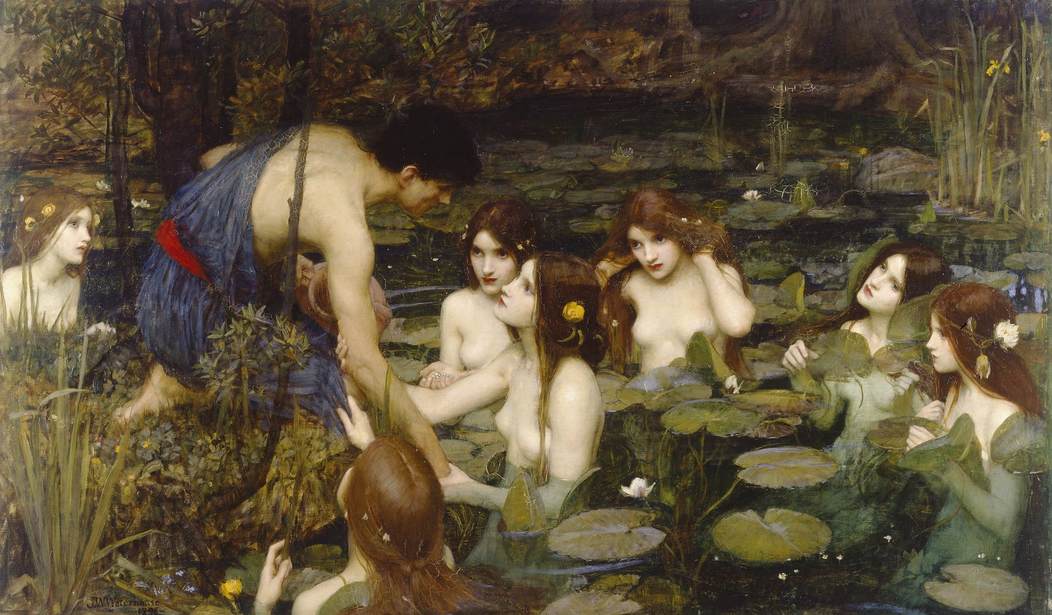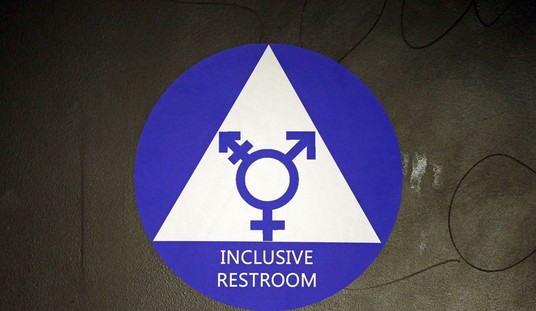Not content with tearing down monuments and hollowing out cultural institutions in the name of “social justice” (which is simply a fancy term for revenge), the totalitarians of the Left have now turned their basilisk glare on historic works of art. Case in point, Hylas and the Nymphs by one of the foremost artists of the pre-Raphaelite movement in Britain, J. W. Waterhouse. A flap over this painting arose the other day when the Manchester Art Gallery removed the work over “sensitivity” issues:
A gallery has temporarily removed a Victorian painting of naked adolescent girls in a move to “encourage debate” about how such images should be displayed in the modern age. Manchester Art Gallery has taken down Hylas and the Nymphs by JW Waterhouse. Curator Clare Gannaway said there were “tricky issues about gender, race and representation” in the gallery. “But we want to talk about that with people.” She denied accusations that the gallery was censoring the 1896 picture.
The decision has already sparked a heated reaction, however, with many on social media accusing the gallery of being puritanical and too politically correct. The painting was one of a number of similar pictures in a gallery area titled In Pursuit of Beauty, which Gannaway described as “very old-fashioned” because it depicts women as “either as passive beautiful objects or femmes fatales.”
Idiotic, but entirely expected. The cultural-Marxist Left will not rest until it has destroyed every vestige of the past, a trait it shares with both Islam and various 20th-century Communist revolutions, including in the Soviet Union, China, and Cambodia. The totalitarian impulse always lurks just beneath the deceptively beneficent surface of these satanic movements — which, after all, only want to bring “justice,” “enlightenment,” and “peace.”
Fortunately, for now, the righteous pushback has had an effect:
A gallery is to put a Victorian painting of naked adolescent girls back on display after a row over censorship. Manchester Art Gallery said it took down Hylas and the Nymphs by JW Waterhouse to “encourage debate” about how such images should be displayed. But critics accused curators of being puritanical and politically correct. The painting will return on Saturday. “It’s been clear that many people feel very strongly about the issues raised,” Manchester City Council said.
The painting’s initial removal was filmed to be made into a new piece of video art for artist Sonia Boyce’s exhibition at the gallery in March. Postcards of the painting were also taken out of the gallery shop.
(In case you’re wondering who Sonia Boyce is: “Focusing on work from the mid-1990s to the present the exhibition will reflect Boyce’s move from her earlier drawing and collage which explored her own position as a black British woman, towards more improvised, collaborative ways of working. These unpredictable, open processes have been documented through a range of media including photography, film and wallpaper. The gallery has also commissioned Boyce to make a new collaborative live work for the exhibition.”)
Let’s start with this: Waterhouse’s painting, which depicts a scene from Greek mythology, is not a painting of “naked adolescent girls.” It is a painting depicting imaginary nymphs. These particular nymphs are, as nymphs are wont to be, beautiful young, naked females, whose unadorned forms and figures have been celebrated in Western art since the time of the Greeks themselves. But leave it to the neo-Victorian prudes to seek to remove a Victorian-era painting from public view on the grounds of contemporary “feelings.”
The gallery’s interim director Amanda Wallace said: “We were hoping the experiment would stimulate discussion, and it’s fair to say we’ve had that in spades – and not just from local people but from art-lovers around the world. “Throughout the painting’s seven day absence, it’s been clear that many people feel very strongly about the issues raised, and we now plan to harness this strength of feeling for some further debate on these wider issues.” The gallery is now planning a series of public events “to encourage further debate.”
Hold it right there — there should be no further “debate,” because there’s absolutely nothing to debate about institutional censorship. Do we really need further discussion about “gender issues and sexuality”? On the Left, the answer is: of course we do:
Last week, in advance of a retrospective of Boyce’s work, a mediocre, semi-pornographic Victorian painting in Manchester Art Gallery, was replaced with a notice explaining that a temporary space had been left “to prompt conversations about how we display and interpret artworks in Manchester’s public collection”. Members of the public have stuck Post-it notes on the wall giving their reaction.
But the response from some critics to the removal from public view of the painting, Hylas and the Nymphs by John William Waterhouse, has been a torrent of barely disguised contempt and ire, and accusations of censorship.
Such complaints willfully obscure the role that art institutions play in shaping our cultural identities through exhibitions and displays. Who chooses these important narratives and determines what is, or is not, a legitimate part of the national cultural story? At a time when Britain is painfully reconfiguring its identity in relation to Europe and the rest of the world, and campaigns such as Black Lives Matter and #MeToo are exposing once again the fault lines of racism and sexism, we need cultural institutions to be self-reflexive, and critical about the mirrors they hold up. Now, more than ever, museums should be questioning themselves and their audiences.
On the contrary — now, more than ever, in the teeth of these fascists, museums should rededicate themselves to their institutional purpose, which is cultural preservation, not political activism. One of the functions of art is to address the human condition in non-political ways, and let the readers, listeners, and viewers make up their own minds about the subject without being handed a politically correct trot to guide them in the right way of thinking.
Visitors were invited to write their views about the decision on sticky notes and post them in the vacant space. “Removing art due to political concerns is exactly censorship,” wrote Gary Brooks on Twitter. I think you can spark a debate without removing the painting,” said Ben Perkins .
Professor Liz Prettejohn, who curated a Waterhouse exhibition at the Royal Academy in London in 2009, told BBC News: “Taking it off display is killing any kind of debate that you might be able to have about it in relation to some of the really interesting issues that it might raise about sexuality and gender relationships.
“The Victorians are always getting criticised because they’re supposed to be prudish. But here it would seem it’s us who are taking the roles of what we think of as the very moralistic Victorians.”
As anyone who’s ever read a single page of Sir Richard Burton’s unexpurgated translation of the Arabian Nights knows, the Victorians weren’t so much prudish as they were careful to separate private sexuality from the public sphere, except through art. Their puritanical descendants, on the other hand, parade around in pussy hats and discuss their own physiognomy in the crudest possible terms as they rage against a universe and a God they believe has been plotting against them for millennia.
Which society would you rather live in?









Join the conversation as a VIP Member